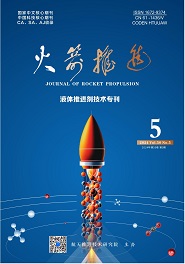航天推进技术研究院主办
ZHANG Ping,LI Bin,GAO Yushan,et al.Engineering correction method for post-necking uniaxial stress-strain curve of ductile copper alloy[J].Journal of Rocket Propulsion,2024,50(02):130-139.[doi:10.3969/j.issn.1672-9374.2024.02.014]
延性铜合金颈缩后力学响应工程修正方法
- Title:
- Engineering correction method for post-necking uniaxial stress-strain curve of ductile copper alloy
- 文章编号:
- 1672-9374202402-0130-10
- 分类号:
- V434.3
- 文献标志码:
- A
- 摘要:
- 液体火箭发动机中大量采用延性铜合金,严苛载荷导致其普遍工作于大塑性变形状态。由于无法有效处理拉伸试验颈缩后数据,传统工程强度分析所用材料本构无法充分反映出材料的真实承载能力。针对某延性铜合金开展常温单轴拉伸试验,并从工程强度分析的角度提出通用修正函数与参数拟合原则,随后通过有限元颈缩仿真拟合得到加权因子w=0.75和指数修正因子n=2.4。研究表明,有限元颈缩仿真的载荷-位移响应对模型参数和网格具有收敛性,指数修正方法可更好地描述铜合金试件颈缩后响应,选取n=2.4可得到偏保守的材料性能估计。
- Abstract:
- Ductile copper alloys are widely used in liquid rocket engines, which are generally subjected to large plastic deformation due to extreme loads. Due to the lack of method to effectively process the post-necking data of tensile tests, traditional material constitutive models used in engineering structural analysis failed to fully reflect the real bearing capacity of materials. Uniaxial tensile tests were carried out at room temperature for a ductile copper alloy, and the universal correction function and parameter fitting principles were proposed from the perspective of engineering structural strength analysis. Then, the weighted factor w=0.75 and the exponential correction factor n=2.4 were obtained through the FEM necking simulation. The results show that the load-displacement response of the finite element necking simulation is convergent to the model parameters and mesh. The exponential correction method can better describe the post-necking response of copper alloy specimens. A conservative material property estimate can be obtained by selecting n=2.4.
参考文献/References:
[1] ANTOLOVICH S D, ARMSTRONG R W. Plastic strain localization in metals: origins and consequences[J]. Progress in Materials Science, 2014, 59(1): 1-160.
[2]BORJA R. A finite element model for strain localization analysis of strongly discontinuous fields based on standard Galerkin approximation[J]. Computer Methods in Applied Mechanics and Engineering, 2000, 190(11/12): 1529-1549.
[3]ZHU Y Z, KANVINDE A, PAN Z F. Analysis of post-necking behavior in structural steels using a one-dimensional nonlocal model[J]. Engineering Structures, 2019, 180: 321-331.
[4]DOWLING N E. Mechanical behaviour of materials[M]. New Jersey: Pearson Education, Inc, 2013.
[5]BRIDGMAN P. The stress distribution at the neck of a tension specimen[J]. Trans. ASM, 1944, 32:553-574.
[6]BRIDGMAN P. Studies in large plastic flow and fracture[M]. New York: McGraw-Hill, 1952.
[7]DAVIDENKOV W. Mechanical methods of testing analysis of the state of stress in the neck of a tension specimen[C]//Proceedings of the ASTM. [S.l.]:ASTM, 1946.
[8]SIEBEL E, SCHWAIGERE S. Mechanics of tensile test[J]. Arch. Eisenhuttenwes, 1948, 19:145-152.
[9]SHAHRJERDI A, RANJBAR B. Correction of post-necking stress-strain curve of copper using surface strain method[J]. Archive of Applied Mechanics, 2022, 92(1): 199-219.
[10]ZHUANG X C, ZHAO Z, LI H Y, et al. Experimental methodology for obtaining the flow curve of sheet materials in a wide range of strains[J]. Steel Research International, 2013, 84(2): 146-154.
[11]JOUN M, EOM J G, LEE M C. A new method for acquiring true stress-strain curves over a large range of strains using a tensile test and finite element method[J]. Mechanics of Materials, 2008, 40(7): 586-593.
[12]ZHU F P, BAI P X, ZHANG J B, et al. Measurement of true stress-strain curves and evolution of plastic zone of low carbon steel under uniaxial tension using digital image correlation[J]. Optics and Lasers in Engineering, 2015, 65: 81-88.
[13]LING Y. Uniaxial true stress-strain after necking[J]. AMP Journal of Technology, 1996, 5:37-48.
[14]JIA L J, KUWAMURA H. Ductile fracture simulation of structural steels under monotonic tension[J]. Journal of Structural Engineering, 2014, 140(5): 04013115.
[15]GAO Y S, ZHANG P, HUO S H. An investigation on the cyclic deformation and service life of a reusable liquid rocket engine thrust chamber wall[J]. Multidiscipline Modeling in Materials and Structures, 2023, 19(3): 522-543.
[16]张凭, 李斌, 高玉闪,等. 重复使用火箭发动机推力室疲劳分析研究进展[J].火箭推进,2024,50(1):12-27.
ZHANG P, LI B, GAO Y S, et al. Research progress of fatigue analysis for the thrust chamber of reusable rocket engines[J]. Journal of Rocket Propulsion,2024,50(1):12-27.
[17]中国钢铁工业协会. 金属-材料 拉伸试验 第1 部分:室温试验方法:GB/T 228.1-2021[S]. 北京:中国标准出版社,2021.
China Iron and Steel Industry Association. Metallic materials tensile:testing:Part 1: method of test at room temperature: GB/T 228.1-2021[S]. Beijing: China Standard Press, 2021.
[18]KALPAKJIAN S. Manufacturing engineering and technology[M]. Hoboken: Pearson Education, Inc, 2006.
[19]贾良玖, 葛汉彬. 强震下金属结构的超低周疲劳破坏[M]. 上海: 同济大学出版社, 2019.
备注/Memo
收稿日期:2023- 08- 28 修回日期:2023- 09- 25
作者简介:张凭(1993—),男,博士,工程师,研究领域为液体火箭发动机组件疲劳寿命。
